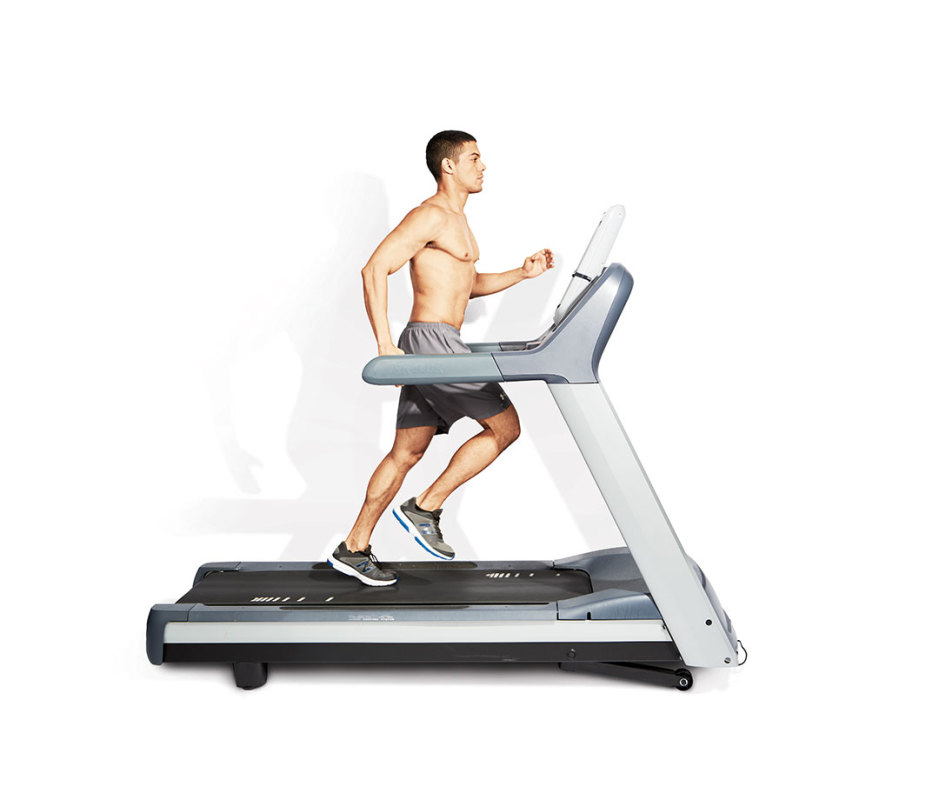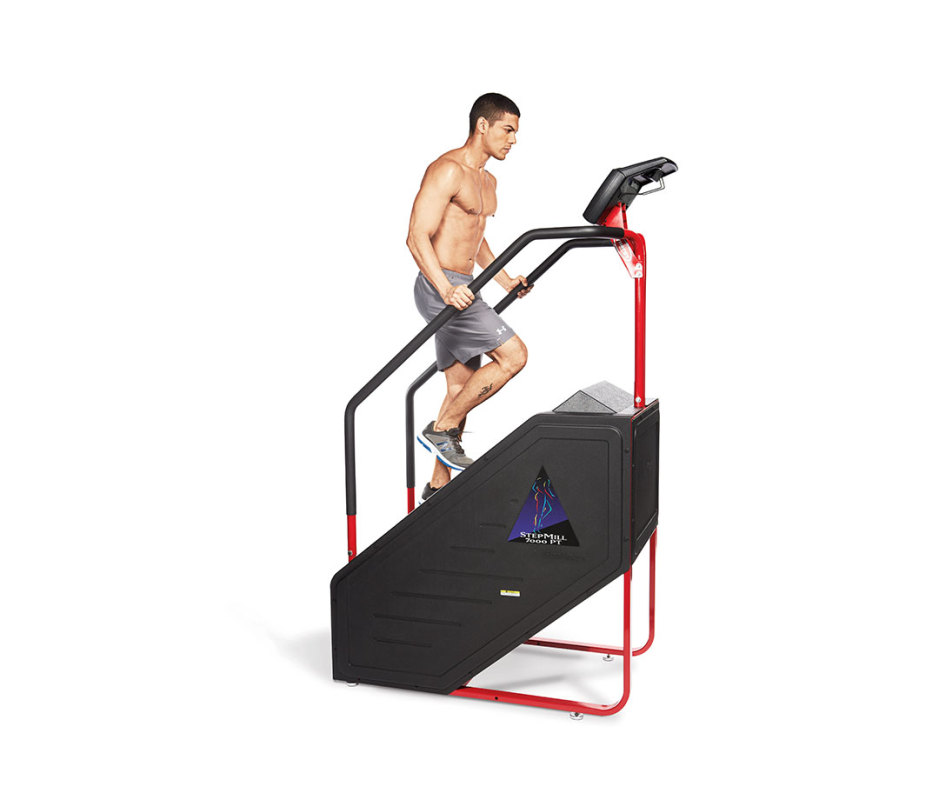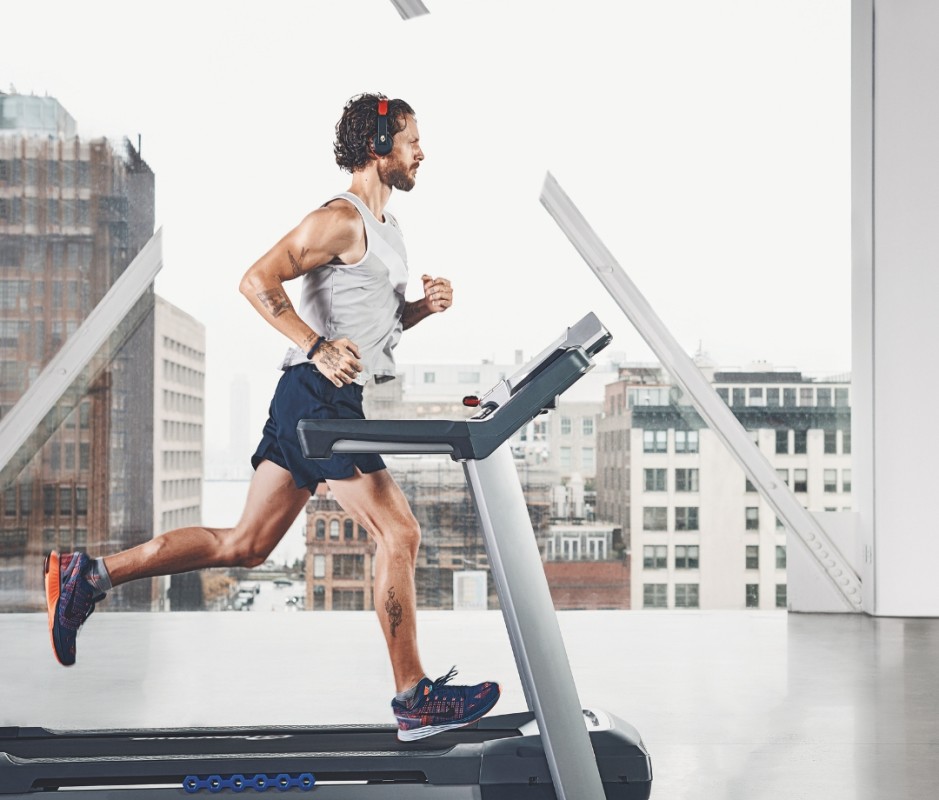After years of talking about your weight loss plan, you’ve finally decided to take action. You hired a personal trainer, have a solid workout routine, and found the motivation you’ve been searching for. But here’s the issue—you want to burn fat and get fit but have limited time. Should you hop on the treadmill? Or start knocking off floors on the StairMaster? The good news: If your goal is to get your heart pumping, your legs burning, and your fitness improving, you can’t really make a wrong choice whether you go with the StairMaster vs treadmill.
“Both are really good for building aerobic capacity. And they’re both fairly equal from a lower body fitness standpoint,” says Shawn Arent, Ph.D., C.S.C.S., chair of the Department of Exercise Science at the University of South Carolina.
But depending on your fitness goals, mobility, and what you want to—or don’t want to—get out of a gym session, the StairMaster or treadmill may be a better cardio workout. Below I discuss what makes each great, some drawbacks for each piece of equipment, and some interval workouts you can use on each machine to help keep your cardio sessions fresh.
Related: This Is The Best Time to Take Creatine, According to Science
StairMaster vs Treadmill: How Are They Different?
Both Improve Cardiovascular Fitness
And they do so to a similar degree. In a 12-week study of active females from 2004, treadmill and StairMaster workouts both improved VO2Max, a measure of the maximum amount of oxygen your body can use during exercise. VO2Max is both a marker of fitness and healthy longevity.
Both Burn Similar Amounts of Calories
You may be wondering which is better the StairMaster vs treadmill for fat loss. In a study comparing lots of different cardio machines, recreationally active men who went all-out on the StairMaster and treadmill burned a similar number of calories per minute. The treadmill burned slightly more (17 calories per minute) than stair climbing (15), but both machines outperformed stationary bikes and elliptical machines.
They’re Both Good for Beginners and Advanced Exercisers
Even if you’ve never scanned a gym membership card before, you already know how to run, walk, and climb stairs. The stair climber might be slightly better for beginners who want to do high-intensity work, says Greg Pignataro, C.S.C.S., founder of Never Past Your Prime, because it “forces you to move in a way that reinforces proper movement mechanics.”
The Mechanics Are Different
The main difference between a stair climber and a treadmill is obvious: Using a treadmill, you’re walking or running on a moving belt, while on the StairMaster or other type of stair climber, you’re climbing steps.
Stair Climbing Is Lower Impact
Running on a treadmill puts more impact on your lower body joints than walking or trotting upstairs. Increasing the speed at which you run on a treadmill increases those joint-jarring impacts, says Ryan Koziol, owner of RYKO Fitness. Bumping up the speed on a StairMaster is still a low-impact form of exercise.
Treadmills Are More Versatile
While you can increase the speed or resistance on a stair climber, Arent says, the treadmill’s ability to adjust speed and incline can provide more flexibility for making the workout easier or harder.
Each Challenge Your Leg Muscles Differently
Both pieces of equipment will challenge all the muscles in your legs, but climbing stairs can provide more overall activation of the quadriceps, the muscles in the front of your thighs, Arent says. Walking or running on the treadmill at an incline closes this gap. And to increase glute activation on a stair climber that is a step mill—a type that has a series of steps that cycle through instead of foot pads—you can skip a step, he says.
Treadmills May Transfer to Sports-Specific Goals
If you want to run 5Ks or other races, you’ll want to actually run, Arent says. And you can only really do that on a treadmill. But a study from 1993 found that college-aged women who did stair workouts for nine weeks improved their time in a 1.5 mile run, though not quite as much as other women who trained on the treadmill for the same period.

Beth Bischoff
Treadmill: Pros and Cons
The treadmill will help you rack up steps and elevate your heart rate. But it’s got other unique pluses that other cardio machines don’t have.
Pros of the Treadmill
If you want to run fast, you’ve got to run, says John Peel, a trainer for iFit and Nordic Track.
“It’s going to suit the trail runner, distance runner, and casual hiker more appropriately,” he says, because the incline can be increased to mimic some of the conditions faced in races.
Experts agree that the best way to run on a treadmill is with some level of incline. This reduces the impact of each step, Pignataro points out, and also makes it less likely that you’ll land on your heel, a jarring impact that can result in injury.
Versatility
Bikes, ellipticals, and step machines can only increase or decrease speed and resistance. Because you can adjust not only the speed but the incline of the treadmill, it may also be the most versatile piece of cardio equipment in the gym.
You can also just walk on a treadmill and get an effective workout, Koziol says. The ability to change multiple variables also lets you do multiple kinds of workouts: It’s easy to train slow, fast, at steady paces, or at different speeds or incline intervals.
Challenging at an Incline
While you may think of a treadmill as a piece of equipment for running, using it to walk at an incline may be even more effective, and it reduces the impact you’d feel while running. Koziol suggests trying to start walking at 5 to 7 degrees of incline, going for 10 to 20 minutes.
Related: Master the 5x5 Workout to Build Strength, Muscle, and Power
Cons of the Treadmill
Leads to Bad Running Mechanics
The treadmill’s moving belt forces you to run differently than you would outside, Pignataro says.
“It’s like having a rug pulled out from under you constantly,” he says. As a result, it’s more difficult to keep your center of gravity landing over the center of your foot. Instead, your leg goes in front of your body, and you land on your heel.
“That’s not the way we’re designed to run,” he says. “The forefoot should be the first point of contact. If you’re landing on the heel first, it’s my professional opinion that you’re doing more harm than good.”
To reduce this effect, run at an incline, he says. Your foot will be on the treadmill for longer on each step, and it’s easier to strike with the center and front of your foot.
Requires Lots of Ankle Mobility at High Inclines
When walking on a treadmill at an extreme incline, your ankle needs to flex so that your toes come toward your shins. This movement is called ankle dorsiflexion, and not everyone has great mobility in this way, Arent says.
If this is causing you discomfort, the stair climber may be better for you.
High Impact
Especially when running at low or zero incline, the treadmill is jarring. With each step slamming onto the belt, you’re sending shocks up through your feet, ankles, knees, and hips. This can result in overuse injuries or pain in the long haul, Koziol says.
Boring and Repetitive
There’s a reason the treadmill is sometimes called the “dreadmill.” While it can be the only option for certain exercisers to run during colder months, running on the treadmill can still be a drag.

Beth Bischoff
StairMaster: Pros and Cons
Climbing on a StairMaster, step mill, or other stair climbing machine is a great option for meeting the weekly recommendation of 150 minutes of moderate or vigorous cardiovascular activity. Plus, it also has some bonus benefits that other cardio machines can’t provide. But buyer beware, there are also a few nitpicky drawbacks to consider. Follow along as we answer what is the StairMaster good for and the cons of using the machine:
Pros of the StairMaster
Encourages Good Movement Mechanics
Unlike the treadmill, which can lead to heel striking, climbing on a step mill or StairMaster “forces you into better mechanics automatically,” Pignataro says. This means that you’ll step and land on the front and center of your foot instead of with the heel. “It’s basically impossible to climb stairs on your heels.”
This foolproof mechanical advantage makes the stair climber less likely to get you hurt, he says, and also an ideal choice for beginning exercisers.
A Challenging Workout
No surprise here. Climbing stairs is harder than moving at the same pace on flat ground (or a flat treadmill). You’ll be able to get to higher intensities at lower speeds, Koziol says, which has an added bonus: You can work harder without increasing the impact of the exercise on your joints.
Greater Quadriceps Activation
Climbing stairs will work all the muscles in your legs, just like walking or running on the treadmill. But the StairMaster will work the quadriceps, the muscles in the fronts of your thighs, a little harder, Arent says.
Climbing the steps at a fast pace will also work the muscles in the back of your legs, also known as your posterior chain, harder than flat or low-incline treadmill walking or running, Peel says.
Related: A Complete Guide to Perfecting Romanian Deadlifts
Cons of the StairMaster
Burns Slightly Fewer Calories
In a study that compared 10 different cardio machines, the step mill—the kind that has a revolving staircase you climb—burned an average of 354 calories in 30 minutes, the second-most among the different exercises studied. The only machine that beat it was the treadmill, but not by much: Exercising at a similar intensity, treadmill exercisers burned 378 calories.
Only Speed or Resistance Can Be Changed
On a step mill, the type of StairMaster with steps that rotate, the height of the stairs can’t be adjusted. For some exercisers with knee issues, Arent says, this can cause some discomfort.
If you’re using an older-style stepper, where the foot pads connect to the machine by metal arms and go up and down, you can shorten your steps, he says, to find a range that doesn’t cause knee discomfort.
More Challenging
For some exercisers, this is a pro, but for others, the challenge of bounding up stairs is a deterrent. The solution, Koziol says: Go slower. Walking at an incline on a treadmill is tough at a slow speed, and so is climbing stairs. If your heart rate is elevated, you’re getting a good workout—even if it’s not as fast as you’d run.
It Can Get Repetitive
Like the treadmill, the scenery doesn’t change when you’re on the stair climber. It can get boring.

James Ryang
Great Workouts to Do On the Stairmaster and Treadmill
While both the StairMaster and treadmill work for steady state cardio, there’s more you can do than just hop on either of these machines and move for 30 minutes. Try these variations when incline walking, incline running, or on the StairMaster.
Incline Walk the 12/3/30 Workout
When you increase the incline on a treadmill, Koziol says, the change in difficulty ramps up quickly with each uptick in slope. So even walking slowly provides a serious challenge.
Case in point: His favorite treadmill workout, called “12/3/30.”
“It’s a 12 percent incline at 3 mph for 30 minutes,” he says. Even at this slower pace, the ramp will be a challenge. If it’s too hard, he says, start at a slightly lower incline and work your way up.
Incline Walking or Running Intervals: Challenge yourself for 30 seconds
High-intensity interval training (HIIT), where bouts of high-intensity work are alternated with lower-intensity work or rest, is a time-efficient way to burn calories on either machine. These workouts go by quickly, Peel says, and work up a great sweat with less repetitive ruminating than a steady-state bout.
Set the speed and incline at a level where you’ll be challenged for 30 seconds, Peel says. After 30 seconds of work, step to the sides of the belt to recover for 30 seconds. Repeat for 10 to 20 rounds.
StairMaster Intervals: Use Resistance/Levels
Koziol loves the StairMaster for interval training. For easier efforts, he says, set the StairMaster at a level where you’re walking very slowly up the stairs—almost like you’re trudging. This could be a level 3 on the StairMaster for many exercisers.
“There is no ‘too slow’ here,” he says.
For the harder efforts, set it at a level, probably between 6 to 10, where it’s like you’re rushing up the stairs (imagine you’re late for a meeting, and the elevator’s on the fritz).
Perform seven rounds of 1 minute of the hard effort, followed by the easy effort for the same amount of time. Try this workout on its own for a cardio day, or at the end of your strength workout.
Related: 15 HIIT Workouts to Get You Shredded Fast
StairMaster vs Treadmill: Frequently Asked Questions
Which is better for fat loss?
Either one will work well. There is no “best” cardio method for burning fat. Studies have found that for maximum fat burning during exercise, people with more than 35 percent body fat will burn the most working between 61 to 66 percent of their maximum heart rate. People with body fat percentages below 35 will burn the most between 57 to 64 percent of their max heart rate.
While you’ll burn more fat during cardio workout at these lower intensities, studies have shown that when the amount of work done is evened out, there’s very little difference in calories and fat burned over a 24-hour period with high vs low-intensity cardio.
Should I hold on to the handles?
Only if you need to balance. Holding on significantly reduces how difficult both the treadmill and StairMaster are since they reduce the amount of body weight you need to move, Arent says. To maximize your results and simultaneously train your core to hold you upright, keep your hands off the handles if you can.
Is running on a treadmill the same as running outside?
For running form, no. Running on the treadmill can cause you to strike with your heels, Pignataro says, resulting in jarring impacts. And at higher speeds, he says, running on the treadmill isn’t so much running as it is skipping or bouncing on a moving belt.
From the perspective of the number of calories you’ll burn, running outside and on a treadmill are pretty close, though. In a 2019 meta-analysis, scientists found that when running on the treadmill—even without an incline—study participants used as much oxygen as they did for outdoor running at speeds up to six minutes per mile.
Related: Push, Pull, Legs Program: Simple Regimen to Build Muscle
from Men's Journal https://ift.tt/hc5bm04
via IFTTT
